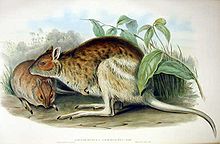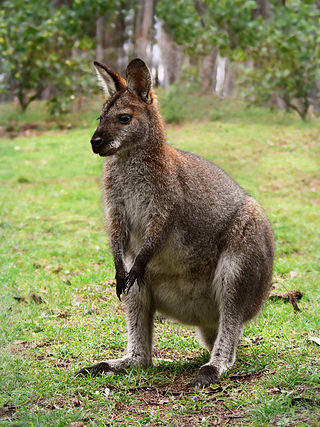
A wallaby is a small or middle-sized macropod native to Australia and New Guinea, with introduced populations in New Zealand, Hawaii, the United Kingdom and other countries. They belong to the same taxonomic family as kangaroos and sometimes the same genus, but kangaroos are specifically categorised into the four largest species of the family. The term "wallaby" is an informal designation generally used for any macropod that is smaller than a kangaroo or a wallaroo that has not been designated otherwise.

Tree-kangaroos are marsupials of the genus Dendrolagus, adapted for arboreal locomotion. They inhabit the tropical rainforests of New Guinea and far northeastern Queensland, along with some of the islands in the region. All tree-kangaroos are considered threatened due to hunting and habitat destruction. They are the only true arboreal macropods.
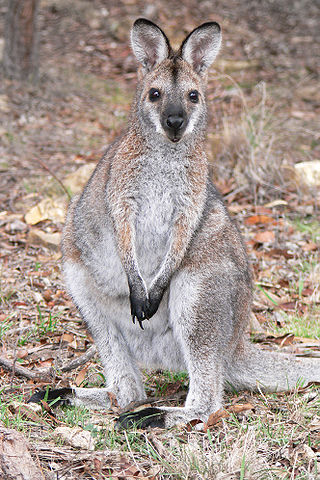
Macropodidae is a family of marsupials that includes kangaroos, wallabies, tree-kangaroos, wallaroos, pademelons, quokkas, and several other groups. These genera are allied to the suborder Macropodiformes, containing other macropods, and are native to the Australian continent, New Guinea and nearby islands.

The banded hare-wallaby, mernine, or munning is a marsupial currently found on the islands of Bernier and Dorre off western Australia. Reintroduced populations have recently been established on islands and fenced mainland sites, including Faure Island and Wadderin Sanctuary near Narembeen in the central wheatbelt.

The eastern hare-wallaby, once also known as the common hare wallaby, is an extinct species of wallaby that was native to southeastern Australia. It was first described by John Gould in 1841.

Threatened fauna of Australia are those species and subspecies of birds, fish, frogs, insects, mammals, molluscs, crustaceans, and reptiles to be found in Australia that are in danger of becoming extinct. This article lists species classified as threatened species under the Commonwealth Environment Protection and Biodiversity Conservation Act 1999.
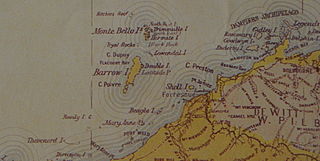
Barrow Island is a 202-square-kilometre (78 sq mi) island 50 kilometres (31 mi) northwest off the Pilbara coast of Western Australia. The island is the second largest in Western Australia after Dirk Hartog Island.

The spectacled flying fox, also known as the spectacled fruit bat, is a megabat that lives in Australia's north-eastern regions of Queensland. It is also found in New Guinea and on the offshore islands including Woodlark Island, Alcester Island, Kiriwina, and Halmahera.
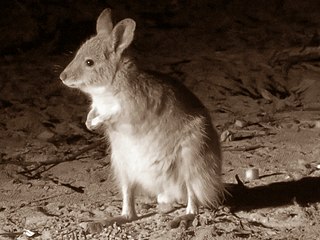
The rufous hare-wallaby, also known as the mala, is a small macropod found in Australia. It was formerly widely distributed across the western half of the continent, but naturally occurring populations are now confined to Bernier Island and Dorre Island Islands off Western Australia.
The Lake Mackay hare-wallaby, also known as the central hare-wallaby or kuluwarri, is an extinct species of macropod formerly found in central Australia. Very little is known about it.

Lagorchestes is a genus of small, rabbit-like mammals commonly known as hare-wallabies. It includes four species native to Australia and New Guinea, two of which are extinct. Hare-wallabies belong to the macropod family (Macropodidae) which includes kangaroos, wallabies, and other marsupials.
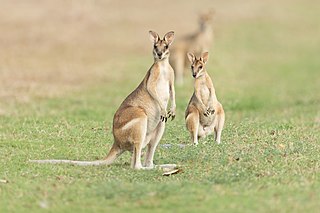
The agile wallaby, also known as the sandy wallaby, is a species of wallaby found in northern Australia and southern New Guinea. It is the most common wallaby in north Australia. The agile wallaby is a sandy colour, becoming paler below. It is sometimes solitary and at other times sociable and grazes on grasses and other plants. The agile wallaby is not considered threatened.

The northern or sandy nail-tail wallaby is a species of macropod found across northern Australia on arid and sparsely wooded plains. The largest species of the genus Onychogalea, it is a solitary and nocturnal herbivorous browser that selects its food from a wide variety of grasses and succulent plant material. Distinguished by a slender and long-limbed form that resembles the typical and well known kangaroos, although their standing height is shorter, around half of one metre, and their weight is less than nine kilograms. As with some medium to large kangaroo species, such as Osphranter rufus, they have an unusual pentapedal motion at slow speeds by stiffening the tail for a fifth limb. When fleeing a disturbance, they hop rapidly with the tail curled back and repeatedly utter the sound "wuluhwuluh". Their exceptionally long tail has a broad fingernail-like protuberance beneath a dark crest of hair at its end, a peculiarity of the genus that is much broader than the other species. The name unguifera, meaning claw, is a reference to this extraordinary attribute, the purpose of which is unknown.

The short-eared rock-wallaby is a species of rock-wallaby found in northern Australia, in the northernmost parts of the Northern Territory and Western Australia. It is much larger than its three closest relatives, the eastern short-eared rock-wallaby, the nabarlek and the monjon.

Nabarleks, are a tiny species of macropod found in northern Australia. They are a shy and nocturnal animal that resides in rocky hollows and forages in the surrounding area. Their diet is grasses, sedges, and ferns found in and around their scrub covered refuges. They are distinguished by a reddish tinge to the mostly grey fur and a distinct stripe at the cheek. They move with great speed and agility when observed, with a forward leaning posture and a bushy tail that arches over the back.
The grassland mosaic-tailed rat, or grassland melomys, is a species of rodent in the family Muridae. It is found in Australia and Papua New Guinea. In Australia it is found along the northern coast from Kimberley to New South Wales. In the Top End it is often found in Pandanus. Kunwinjku of western Arnhem Land call this animal mulbbu.
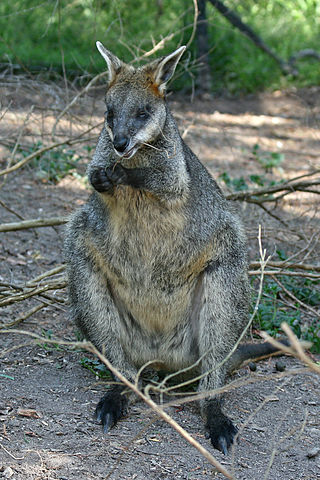
Macropodinae is a subfamily of marsupials in the family Macropodidae, which includes the kangaroos, wallabies, and related species. The subfamily includes about ten genera and at least 51 species. It includes all living members of the Macropodidae except for the banded hare-wallaby, the only surviving member of the subfamily Lagostrophinae.

The Trans Fly savanna and grasslands are a lowland ecoregion on the south coast of the island of New Guinea in both the Indonesian and Papua New Guinean sides of the island. With their monsoon and dry season climate these grasslands are quite different from the tropical rainforest that covers most of the island and resemble the landscape of northern Australia which lies to the south.



